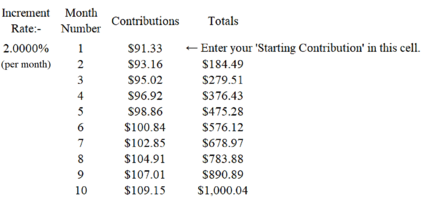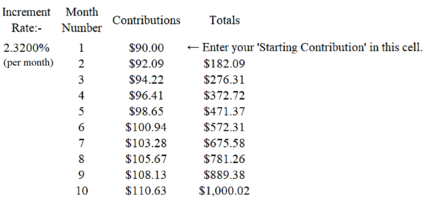Hi everyone. I'm new here.
Math (and school in general) was a looong time ago and I don't know how to do the following:
Over X months I want to save Y dollars.
For example, in 10 months I want to save 1000 dollars.
This is a monthly contribution to savings of 100 dollars.
But I do not want to contribute a fixed amount each month.
I want to increase the monthly contribution at a rate of Z %.
Let's say I start with 100 dollars and increase this at a rate of 2%.
This adds up to a total of 1094,97 which is too much.
Am I wrong in thinking it's impossible to calculate the starting contribution if only the desired total savings Y, the period X and the monthly contribution increase Z% are known?
I'm not looking for a formula (but wouldn't mind getting one of course) but it would be super helpful if someone could point me in the right direction. I would be thankful either way
Math (and school in general) was a looong time ago and I don't know how to do the following:
Over X months I want to save Y dollars.
For example, in 10 months I want to save 1000 dollars.
This is a monthly contribution to savings of 100 dollars.
But I do not want to contribute a fixed amount each month.
I want to increase the monthly contribution at a rate of Z %.
Let's say I start with 100 dollars and increase this at a rate of 2%.
| First month | 100 |
| Second month | 102 |
| 3 | 104,04 (2% of 102) |
| 4 | 106,12 (2% of 104,04) |
| 5 | 108,24 |
| 6 | 110,41 |
| 7 | 112,62 |
| 8 | 114,87 |
| 9 | 117,17 |
| 10 | 119,51 |
This adds up to a total of 1094,97 which is too much.
Am I wrong in thinking it's impossible to calculate the starting contribution if only the desired total savings Y, the period X and the monthly contribution increase Z% are known?
I'm not looking for a formula (but wouldn't mind getting one of course) but it would be super helpful if someone could point me in the right direction. I would be thankful either way


